#tanzania safari from arusha
Explore tagged Tumblr posts
Text
Top 15 Tanzania Safari Locations: A Guide for Wildlife Enthusiasts
Plan your dream safari with my list of the top 15 safari locations in Tanzania. Discover the stunning wildlife and landscapes that make Tanzania a top safari destination.
The continent of Africa is renowned for its spectacular wildlife. Undoubtedly, one of the most popular safari spots in Africa is the breathtaking country of Tanzania. If you are starting to plan your once-in-a-lifetime safari adventure in Tanzania, then you are in luck. In this article, I will outline the top 15 Tanzania safari locations for you to review. Tanzania is renowned for its stunning…
#african safari best places to go#safari tanzania big five#safari tanzania katavi#tanzania best safari lodges#tanzania safari animals#tanzania safari animals list#tanzania safari best#tanzania safari best months#tanzania safari best time#tanzania safari big 5#tanzania safari blog#tanzania safari crater#tanzania safari destinations#tanzania safari experience#tanzania safari from arusha#tanzania safari from dar es salaam#tanzania safari from zanzibar#tanzania safari guide#tanzania safari itinerary#tanzania safari kilimanjaro#tanzania safari map#tanzania safari migration#tanzania safari national park#tanzania safari ngorongoro crater#tanzania safari parks#tanzania safari parks map#tanzania safari places#tanzania safari serengeti
0 notes
Text
Photo safari to Tanzania Jan. 2024, part 1
Nancy and I had a once-in-a-lifetime opportunity to go on a photo safari. A friend of Nancy's mentioned she was leaving in 30 days for her 30th trip to Africa. Nancy said that would be cool and her friend said “come with us.” So we did.
Ruth and Bob had been with our guide Raffy recently and he was starting his own guide service. So here we are on a 10-day safari with a new business owner who is going to pull out all the stops for his first clients. Plus Ruth is almost as knowledgeable about the birds and animals of Africa herself.

Above is Ruth, Nancy, Dana and Bob at the gateway to the Serengeti about day 7 of our adventure.
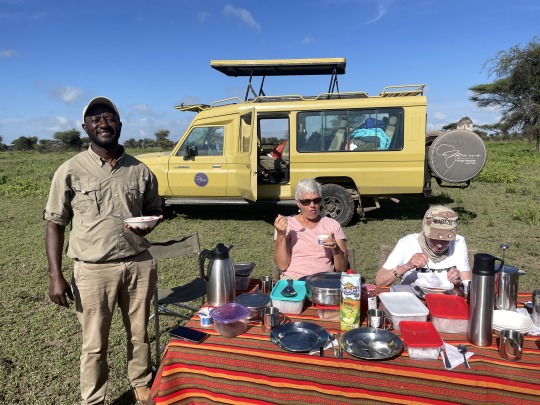
Here is Raffy, Nancy and Ruth having breakfast in the middle of the Ndutu Conservation Area. This is typical of our days. We are always the first jeep out of camp as the sun is just lightening the sky. After several hours of viewing lions, zebras, wildebeest, and gazelle. Raffy parks us in the open and we break out the breakfast provided by the camp.

Did we get to see animals up close?
You bet we saw them all, here is a tonsil check on a male lion of the Upper and Lower Marsh Pride. Hopefully, I have your attention and will start over at the beginning of the journey.
Nancy and I flew Miami-Philly-Doha, Qatar on American Airlines. Doha is about the cleanest prettiest airport in the world. Since we had a 7 hour break there and needed to get on Tanzania time. We opted for a private cubicle to sleep in. Pay by the hour, nice bunks and just what we needed. Leaving Doha at 0115 in the morning we flew 5 hours to Killamanjaro Airport (JRO) in Tanzania.

Changing of the Guard. Turns out that the Captain flying us from Miami to Philadelphia is none other than a former First Officer of mine in Miami, Brandon Lozano. On our flight was his soon-to-be in-laws, Dawn and Mike. We have to get back quickly from this journey since we are invited to Brandon and Jackie’s wedding in Key Largo. Super smooth flight, Capt. thanks for the ride!


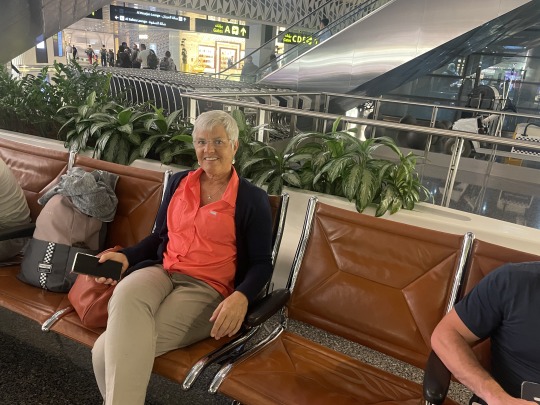

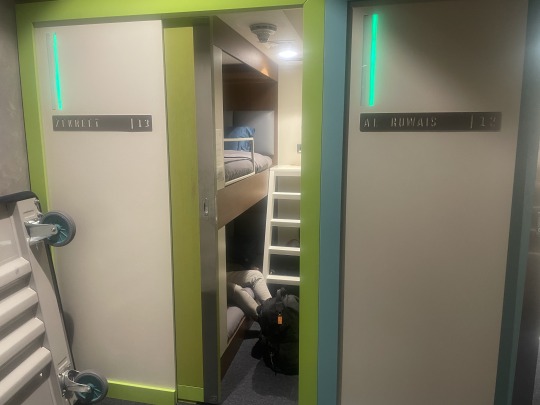
Doha airport and Nancy in our “Sleep N’ Fly” bunk room.

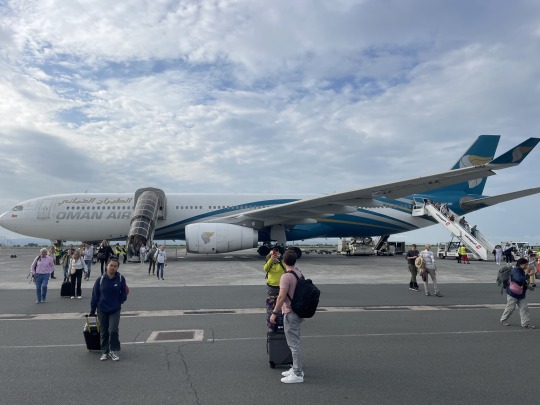
Kilimanjaro Airport and Qatar aircraft we arrived on. My visa had been approved prior to the trip but Nancy’s had not. Turned out not to be a big deal, and they allowed her in the country. Everyone we met in Tanzania could not have been nicer, starting with the Customs and Immigration officials. This country knows their future lies with tourism. Every person we met including all the camp staff, asked us to tell our friends about Tanzania and to come back soon.
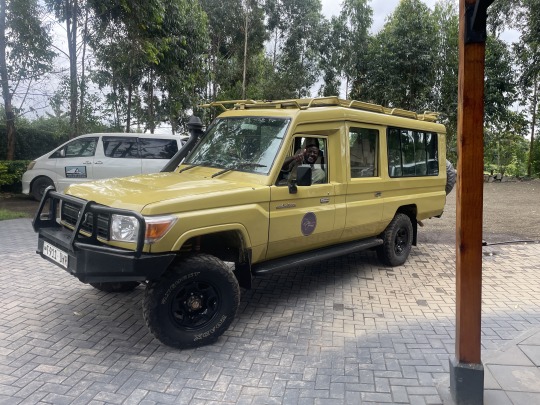

This is “Simba” a 10-year-old 300,000-mile 4-wheel drive Toyota Jeep Land Cruiser. Raffy and John met us at the airport and drove us to our first lodge, Shamba. We were the only guests at the five-cabin lodge. Outstanding staff and great food. “Simba” is Swahili for Elephant.
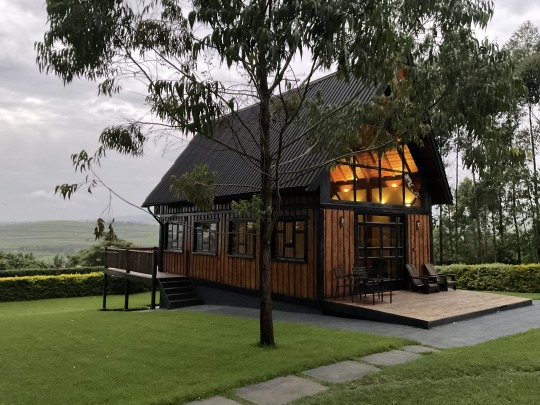
This cabin has a loft with a huge bed upstairs, bath and kitchen downstairs.
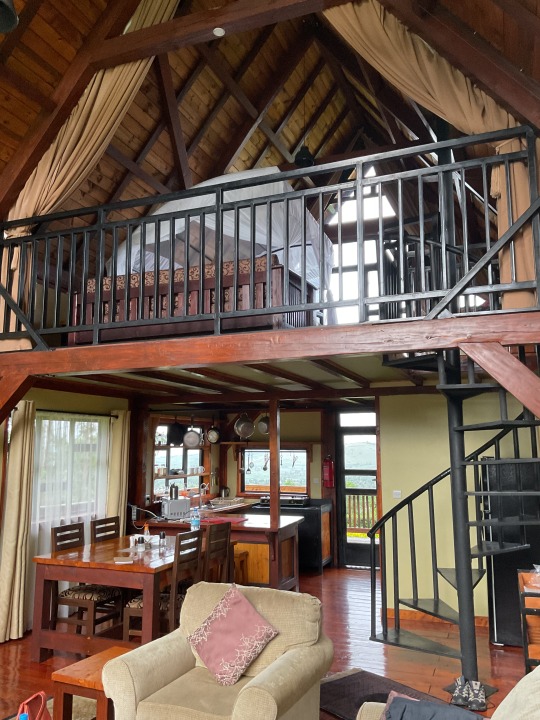
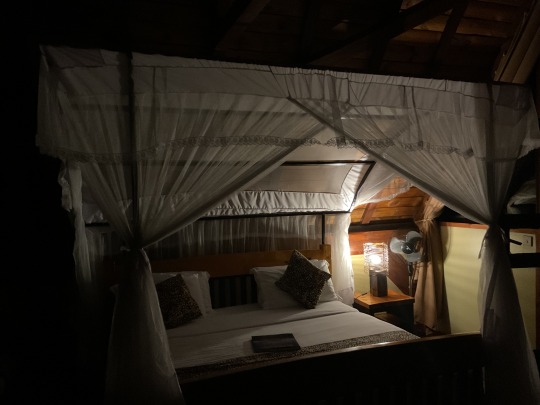
Mosquito nets surrounding the beds is standard in Africa. Even though there very heavy rains the weeks before we arrived, we only had one or two mosquito bites.

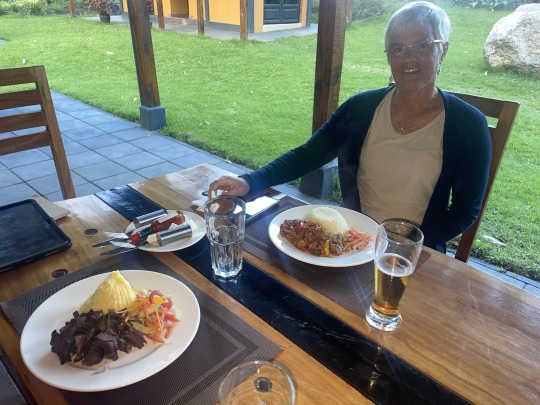
Sitting by the “Camp TV” in the evenings as it chilled down. Nancy at dinner.

While we waited for Ruth and Bob to arrive in Arusha, Tanzania. We spent one day with Raffy in Arusha National Park. This was going to be our appetizer for the parks. A small park but it did have a monkey we would not see in any other park. So we got to see our first giraffe, elephant, zebras and baboons.
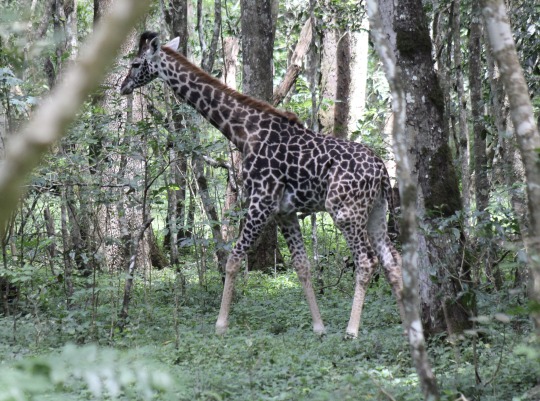
Once into the park, Raffy took a side road through the heavy woods. It was a road less traveled. Which is Raffy’s style. We ran across several giraffes which made the entire safari worthwhile in Nancy’s eyes. Things would only get better. The only giraffe in Tanzania is the Masai Giraffe.
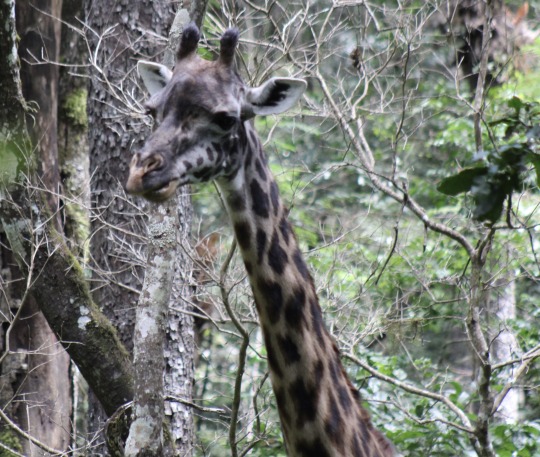
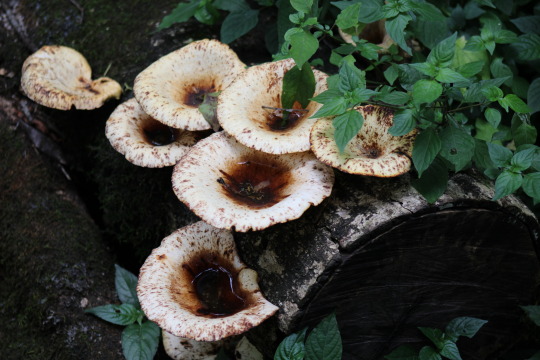

Above is a very elusive “Harvey’s Red Duiker”, which is a very small deer. We saw a couple and were lucky to get this photo. I think they get the prize for the homeliest-looking deer.


This is the seventh-highest mountain in Africa, Mt. Meru at 14,980 ft. It is inside the park. Many hikers spend three days hiking up to the summit. Each group of hikers is required to have 2 armed Rangers to protect them from predators.
Above Nancy is standing up in the jeep and taking photos. Tremendous viewing with the top raised.
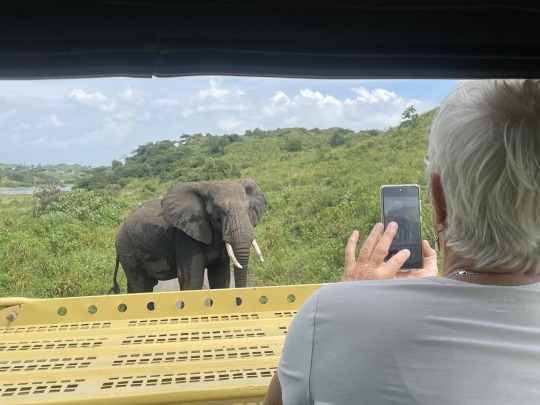
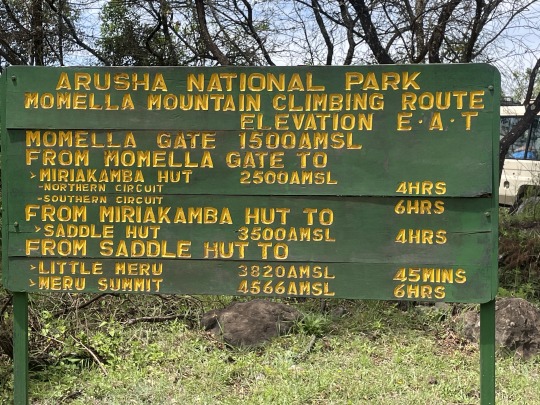
Nancy face to face with her first of many elephants. This is an older male. He was a half mile behind a female with a juvenile. Elephants have 7 sets of teeth. They wear each of the sets out in about 10 years. This guy was probably on his last set. He was not in great shape. You may have heard about elephant graveyards. Where there are multiple elephant skeletons. These graveyards are in the easiest food-gathering places for elephants that have lost their teeth. Once they lose their teeth they basically starve to death.
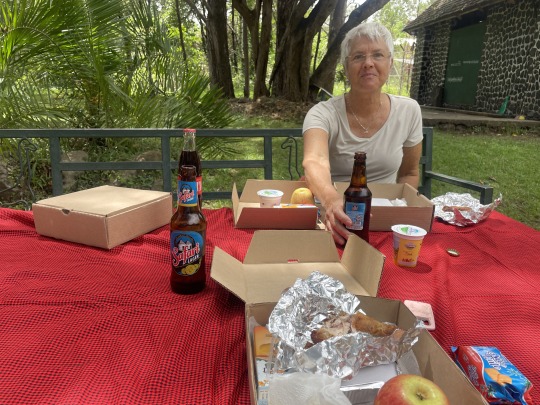
This is our lunch break at a park site, that provides picnic tables and restrooms. Armed park rangers are nearby and ready to escort hikers to the top of the Mt. Meru.
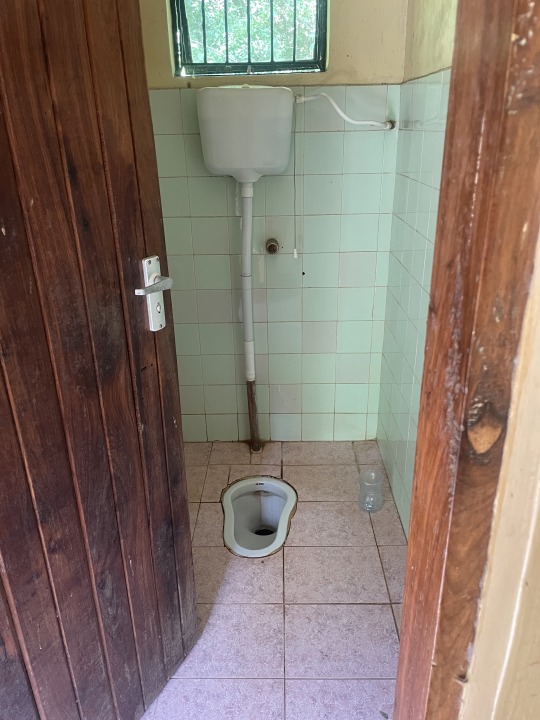
This is life in a third-world country. Using gravity, not much to break; just saying….
Out of permitted photos. check out part 2. above.
If you are interested in your own African Safari, check out Raffy’s website: https://maweafricanventure.com
4 notes
·
View notes
Text
8 DAYS UGANDA PRIMATES AND TANZANIA WILDERNESS SAFARI
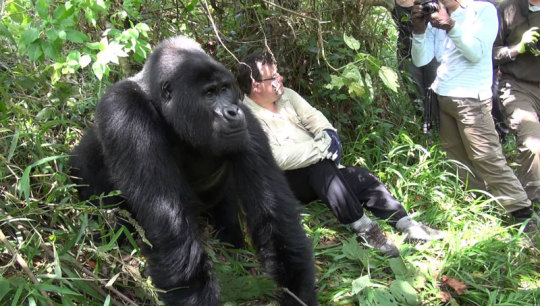
Day 1: Transfer to Bwindi Impenetrable Forest national park-The Home of Mountain Gorillas.
Upon arrival at Entebbe Airport, you will be picked up by our driver guide from the guest house and embark on a road trip to western Uganda, aiming the Gorilla land of Bwindi Impenetrable Forest National Park. This is a long day drive with lunch stop over en route. Though long, the drive takes you through different features to include tropical rain forests, savannah fields and the terraced hills of Kigezi famously known as the Switzerland of East Africa. Drive to the lodge for relaxation as you wait for the next day’s adventure with dinner and overnight at Ride 4 a Woman
Day 2: Gorilla Trekking in Bwindi Impenetrable Forest National Park
After breakfast, you will head to the park headquarters for briefing by park ranger guides, to start Gorilla trekking – the activity can last up to 4 hours trek or more to find the Mountain Gorillas as you hike up and down the slopes with dense mist covered vegetation. This active quest will eventually bring you to the face of one of the most sought-after creatures-the mountain Gorillas. Upon reaching them, you will have 1 full hour with them while observing and learning their behavior as you take photos. You will have dinner and overnight at Ride 4 a Woman
Day 3: Game drive in Ishasha sector to search for tree climbing Lions and transfer to Northern Queen Elizabeth
Have an early breakfast and check out of your lodge and head to Ishasha sector of Queen Elizabeth National Park. The sector is small but has a bountiful of wildlife and is famous for the tree climbing lions. You will a game drive to try your luck of getting a glimpse of some of these lions as they lazily rest in the fig trees. After the drive have lunch at Topic Lodge and continue northwards to Kyambura sector of Queen Elizabeth National Park. Dinner and Overnight at Pumba Safari Cottages.
Day 4: Chimpanzee trekking in Kyambura gorge in Queen Elizabeth National Park
Have an early morning breakfast and head to Kyambura gorge Forest for Chimpanzee trekking to meet man’s closet cousins in the wild. The stunning Kyambura (or Chambura) Gorge also called the “Valley of Apes” is located in the far eastern corner of the well- known Queen Elizabeth National Park in south western Uganda. The landscape is among the most impressive you will find in Uganda and it is swarmed a rich wildlife bio-diversity that comprises of primates, wild animals as well as birds. Later embark on
an exciting road trip back to Entebbe with lunch en route, arriving in the evening for refreshment, and later dinner and overnight at Via Via Guest House.
Day 5: Transfer to Entebbe international airport for your flight to Arusha in Tanzania
After having breakfast or lunch depending on your scheduled flight, you will be transferred back to Entebbe to readily check in and board your flight to Tanzania as you say fare well to the pearl of Africa! You will spend an overnight at Arusha Planet Lodge.
Day 6: Transfer to Tarangire National Park for Wildlife View drive
Morning pickup from the Kilimanjaro Airport in Arusha and drive to Tarangire national park 3 hours driving to the park gate. Arrive for afternoon and evening game drive inside the park. Enjoy game drive inside the park with great chance to see lions, giraffes, zebra, impala and many more. Later during evening drive to Karatu for dinner and overnight at Tarangire Simba Lodge.
Day 7: Transfer to the Great Serengeti National Park for Wildlife View
After breakfast with your packed lunches around 7am start drive toward Serengeti national park via Ngorongoro conservation area it will take you 6 hours to be in the park, enjoy nice view of Manyara escarpment, Ngorongoro highlands, wildlife and many more. Arrive for afternoon and evening game drive while dinner and overnight at Into Africa Wild Camp.
Day 8: Morning game drive in Serengeti National and drive to Ngorongoro Crater
After breakfast from the packed lunches drive to Ngorongoro for 3 hours. Descend into the crater floor for the game drive, great herd of animal sightings like elephants, wildebeest, zebra and many more have a great view of lakes and the crater. Take you at picnic site and proceed with game drive, later drive to the lodge for dinner and overnight at Rhino Lodge.
2 notes
·
View notes
Text
Beach vacation tours in Africa: Perfect harmony of excitement and tranquillity
Africa's stunning beaches offer the ultimate escape, blending pure relaxation with thrilling adventure and vibrant culture. Whether you dream of the tranquil shores of Seychelles, the lively spirit of Zanzibar, or the scenic beauty of South Africa's coast, Africa promises a perfect beach getaway. Come relax and explore incredible marine life, and embrace the magic of sun-kissed shores on a truly unique coastal adventure!
Why Africa is Your Perfect Beach Destination
Africa’s coastlines, stretching across the Indian and Atlantic Oceans, boast some of the world's most exquisite beach destinations. With pristine white sands, crystal-clear waters, and year-round sunshine, an African beach holiday promises an unforgettable experience. Beyond just lounging, Africa offers a unique blend of culture, adventure, and wildlife. You can seamlessly combine your beach relaxation with thrilling safaris, secluded island explorations, and immersive cultural experiences. It's the perfect harmony of excitement and tranquillity. La Pisada Africa Safaris offers exquisite beach vacation tours in Africa.

Top Beach Destinations to see
Get ready to discover some of Africa's most exciting coastal gems-
Zanzibar, Tanzania - Famous for its untouched white-sand beaches, sparkling waters, and rich cultural heritage.
Seychelles - Known globally for its unique granite rock formations, lush landscapes, and incredibly tranquil beaches like Anse Source d'Argent.
Diani Beach, Kenya- A top destination with picturesque palm-lined beaches, ideal for water sports, snorkeling, and kite surfing.
Bazaruto Archipelago, Mozambique - An idyllic paradise perfect for diving, exploring vibrant coral reefs, and indulging in luxurious resorts.
Cape Town, South Africa - Offers stunning city beaches like Camps Bay, providing a fantastic mix of urban exploration and coastal bliss.
Why Choose La Pisada Africa Safaris
La Pisada Africa Safaris is a proudly Kenyan-owned company with over 20 years of combined experience crafting unforgettable holidays across Africa, including beach vacation tours in Africa. It specializes in personalized, high-quality safari and holiday experiences designed for both Kenyan residents and international travelers.
Tailor-Made Safari Packages - Over 30 expertly curated options to choose from, each crafted with care and first-hand destination knowledge.
Wide African Coverage – They operate across the continent—from Nairobi to Maputo, Cape Town, Kigali, Kampala, and Arusha.
Personalized Service – Its local, Africa-born safari experts provide 24/7 support from the same time zone, ensuring prompt assistance before and during your trip.
Unforgettable Experiences - Whether you want to see the Big 5, witness the Wildebeest Migration, trek with gorillas, or enjoy sundowners on the savannah, we make it happen.
First-Hand Expertise - Every lodge, route, and activity is personally tested and recommended by our experienced team.
Sustainable Travel - 101% of your safari investment stays in Africa, supporting local communities and vital conservation projects.
Authentic African Roots - As a local brand, we understand the land, wildlife, and culture better than anyone.
Whether you are dreaming of a weekend getaway, a luxury beach escape, or a multi-country adventure, La Pisada Africa Safaris will make your African journey truly unforgettable.
#africanbeachgetaway#africabeachtours#tropicalafrica#beachvacationsafrica#zanzibarbeachholiday#seychellesescape#exploreafricabeaches#africancoastaladventures
0 notes
Text
7 Days Serengeti and Katavi Tanzania Safari Tour

www.roadsofadventuresafaris.com
A 7-day safari tour through the Serengeti and Katavi National Parks presents an exceptional opportunity to explore two of Tanzania's most remarkable wildlife destinations. The Serengeti is known for its expansive savannahs and the Great Migration, where millions of wildebeest and zebras traverse the plains. Katavi, on the other hand, is a hidden gem, featuring unique wildlife interactions and fewer tourists. This itinerary allows for diverse wildlife sightings, including elephants, lions, and hippos, while also providing a chance to connect with local cultures. Each day brings new adventures, from thrilling game drives to relaxing moments in nature. This safari is perfect for wildlife enthusiasts and photographers looking to capture the essence of Tanzania’s natural beauty.
Day 1: Arrival in Arusha D
Day 2: Transfer to Serengeti National Park
Day 3: Full Day in Serengeti National Park
Day 4: Morning Game Drive in Serengeti
Day 5: Transfer to Katavi National Park
Day 6: Full Day in Katavi National Park
Day 7: Return to Arusha
Day 1: Arrival in Arusha
On Day 1, arrive in Arusha, the starting point for your safari adventure. After clearing customs, a guide will greet you and transfer you to your lodge for a relaxing afternoon. Take time to acclimatize and enjoy the local atmosphere. You can explore the town, visit markets, or sample traditional Tanzanian cuisine. In the evening, participate in a briefing about the safari itinerary, giving you an overview of what to expect in the coming days. This introductory session is an excellent opportunity to ask questions and prepare for the adventure ahead. Rest well, as the next day marks the start of your wildlife exploration in Tanzania.
Day 2: Transfer to Serengeti National Park
Day 2 begins with an early breakfast before departing for Serengeti National Park. The journey takes you through picturesque landscapes and local villages, providing a glimpse into Tanzanian life. Upon arriving in the Serengeti, settle into your accommodation before embarking on an afternoon game drive. The park is famous for its vast plains and abundant wildlife. Look for elephants, lions, and cheetahs as you explore the diverse habitats. Enjoy a picnic lunch in the park while surrounded by nature. As the day comes to a close, return to your lodge for dinner, sharing stories of the day's wildlife encounters with fellow travelers.
Day 3: Full Day in Serengeti National Park
On Day 3, dedicate the entire day to exploring Serengeti National Park. Start early with a morning game drive, taking advantage of the cooler temperatures when animals are most active. Search for the Big Five, including lions, elephants, and buffalo. After a hearty breakfast at your lodge, continue your safari with visits to different areas of the park, each known for unique wildlife sightings. Enjoy a picnic lunch among the stunning scenery. In the afternoon, look for migratory herds and other wildlife. As the sun sets, return to your lodge for dinner, reflecting on the incredible sights and sounds of the African wilderness.
Day 4: Morning Game Drive in Serengeti
Day 4 begins with another early morning game drive in the Serengeti. This early start allows for optimal wildlife viewing as animals are often more active at dawn. Your guide will help you spot various species, including predators hunting and herbivores grazing. After a morning filled with wildlife encounters, return to your lodge for breakfast. Spend the late morning relaxing or enjoying the lodge's amenities. In the afternoon, venture out for another game drive, focusing on different areas of the park. Keep your camera ready, as you may encounter unique animal behaviors and stunning scenery. Return to your lodge for dinner and share highlights from the day with fellow travelers.
Day 5: Transfer to Katavi National Park
On Day 5, depart the Serengeti and travel to Katavi National Park, known for its remote wilderness and rich wildlife. The journey takes you through beautiful landscapes, with opportunities to spot wildlife along the way. Upon arrival in Katavi, settle into your lodge and take a moment to appreciate the park’s untouched beauty. After lunch, head out for an afternoon game drive. Katavi is famous for its large hippo populations and diverse birdlife. Look for elephants and various antelope species as you explore. The park’s less crowded environment allows for a more intimate wildlife experience. Return to your lodge for dinner, reflecting on the day’s adventures.
Day 6: Full Day in Katavi National Park
Day 6 is dedicated to exploring Katavi National Park. Begin with an early morning game drive, where you may encounter large herds of elephants and buffalo. The park is also known for its unique interactions between wildlife, especially around water sources. After a picnic breakfast in the field, continue your safari, focusing on areas known for their rich biodiversity. In the afternoon, take a guided walking safari to learn more about the local flora and fauna, providing a different perspective on the ecosystem. As the day comes to a close, return to your lodge for dinner, enjoying the sounds of nature as night falls.
Day 7: Return to Arusha
On Day 7, prepare for your return to Arusha. After breakfast, enjoy a final morning game drive in Katavi, taking in the last moments of wildlife viewing. Capture any last photographs of the stunning scenery and animals. Afterward, travel back to Arusha, where you can visit local markets for souvenirs or relax at a café. Enjoy lunch before your transfer to the airport for your departure. This day provides a chance to reflect on your safari adventure, filled with memories of Tanzania's wildlife and culture. Whether planning your next trip or sharing stories, the experiences gained will last a lifetime.
0 notes
Text
Recharge Your Mind and Body with Wellness Vacations in Tanzania
In today’s fast-paced world, finding time to unwind, reflect, and restore your inner balance has never been more important. Wellness travel offers the perfect opportunity to disconnect from daily stress and reconnect with yourself—and there’s no better place to do that than Tanzania. With its stunning natural beauty, tranquil environments, and rich cultural heritage, Wellness Vacations Tanzania offer a transformative experience for body, mind, and soul.
Why Choose Tanzania for Wellness Travel?
Tanzania is not only known for its world-renowned wildlife and iconic landscapes like Mount Kilimanjaro and Serengeti National Park—it's also emerging as a top destination for holistic retreats and healing escapes. From yoga sessions overlooking the savannah to spa treatments using natural African botanicals, wellness vacations here are thoughtfully designed to harmonize with the local environment.
Wellness Vacations Tanzania typically include:
Eco-luxury accommodations in nature-rich settings
Daily yoga and meditation classes
Organic, farm-to-table meals
Guided nature walks and cultural excursions
Therapeutic treatments rooted in African traditions
Whether you're looking for solitude or a group retreat, Tanzania’s peaceful atmosphere offers the perfect setting for renewal.
Stretching Across Tanzania: From Safari to Serenity
What makes wellness travel in Tanzania truly special is the diversity of experiences available. Imagine stretching across Tanzania—starting your day with sun salutations in the lush landscapes of Arusha, spending afternoons in quiet reflection by Lake Manyara, and ending with a soul-stirring safari in the Serengeti.
Travel Floh curates custom itineraries that blend wellness with exploration, allowing you to experience the best of Tanzania's natural and cultural richness while prioritizing your well-being.
Experience Tanzania with Travel Floh
Travel Floh is your trusted partner for crafting meaningful and immersive journeys across East Africa. Their tailored Wellness Vacations Tanzania packages are designed to suit your unique wellness goals—whether you're seeking healing, adventure, or a bit of both.
With local expertise, sustainable travel practices, and a passion for creating unforgettable experiences, Travel Floh ensures that every trip leaves you refreshed and inspired.
Final Thoughts
Tanzania offers more than just a vacation—it offers transformation. If you’re craving a journey that nurtures your body and uplifts your spirit, consider Wellness Vacations Tanzania with Travel Floh. Whether you're dreaming of a yoga retreat in the mountains or meditative walks through the wild, your path to wellness begins here—stretching across Tanzania, one meaningful moment at a time.
0 notes
Text
Experience the Thrill of Gorilla Tracking and Serengeti Safari in One Trip
Taking a trip that combines the thrilling activity of gorilla tracking with the breathtaking Serengeti safari is a wildlife lover's dream. Twiga Tours makes this dream a reality, providing carefully designed itineraries that ensure unforgettable expeditions to East Africa.
With Twiga Tours, visitors can experience both wildlife wonders in a single expertly designed itinerary. This double adventure combines up-close-and-personal primate encounters with the traditional Big Five safari experience. In this blog, we will walk you through planning this ultimate adventure, what to look forward to, and how to make the most out of it.

Gorilla Tracking: A Unique Adventure
Where to Go
Gorilla tracking is undertaken mainly in two countries of East Africa:
Uganda: Within Bwindi Impenetrable National Park, where there are almost half of all the world's remaining mountain gorillas.
Rwanda: Within Volcanoes National Park, which has good trekking trails and easy access.
Twiga Tours provides selective gorilla tracking packages with permits, local guides, luxury lodges, and cultural interactions with local people.
What to Expect
Physical fitness is required to a moderate degree, as hikes can be 2 to 8 hours long based on gorilla sightings. After your group tracks down a gorilla family, you get one enchanting hour with them. You'll see their social interaction — from rambunctious juveniles rolling in the bushes to the dominant-looking silverback guarding his group.
Tips for Gorilla Tracking
Book in advance: Particularly in high seasons. Daily gorilla tracking permits are restricted by Uganda and Rwanda.
Dress for the part: Long sleeves, waterproof boots, gloves, and gaiters prevent insects and terrain.
Take a good camera: But no flash!
Hire a porter: Not only do they assist in carrying your equipment, but they benefit local communities directly.
Gorilla tracking is a moving and humbling experience — one that leaves visitors with a profound feeling of reverence and conservation consciousness.
Serengeti Safari: The Ultimate Wildlife Encounter
Tanzania's Serengeti National Park is world-famous for its wide plains and rich wildlife. A Serengeti safari provides the opportunity to see the fabled "Big Five" as well as the spectacular Great Migration. Twiga Tours' "Glimpse of Serengeti & the Ngorongoro" package offers a complete safari experience with game drives complemented by visits to the Ngorongoro Crater, a UNESCO World Heritage Site.
Highlights of the Serengeti Safari with Twiga Tours:
Expert Safari Guides: Informed guides accompany you around the Serengeti, offering information about the ecosystem and wildlife habits.
Game Drives: Enjoy exhilarating game drives that leave you face to face with Africa's most revered creatures.
Cultural Experiences: Interact with Maasai locals and gain insight into their culture and lifestyle.
Comfortable Accommodation: Relax in tastefully designed lodges and camps that provide comfort in the midst of nature.
Tips for a Serengeti Safari
Layered clothing: Mornings are cold, but by midday it quickly warms up.
Binoculars: For the best wildlife viewing during game drives.
Be flexible: Game drives go where animals move — at times the best view comes with waiting.
Twiga Tours personalizes every Serengeti safari to the traveler's pace and comfort, so you never have to leave a glimpse behind.
Gorilla Tracking and Serengeti Safari Combo
Twiga Tours provides customized itineraries that blend gorilla tracking in Rwanda and Serengeti safari with perfect ease. This gives the traveler the opportunity to see the varied landscapes and wildlife of East Africa on one single trip.
Sample Itinerary:
Day 1-2: Arrive in Kigali, Rwanda. Experience gorilla tracking in Volcanoes National Park.
Day 3: Fly to Arusha, Tanzania. Start your Serengeti safari with a game drive in the Ngorongoro Crater.
Day 4-5: Discover the Serengeti, viewing the Great Migration and other animals.
Day 6: Depart from Arusha.
This itinerary mixes the adventure and relaxation of a safari, with cultural interaction and exploration to create a memorable East African experience.
Planning Your Safari with Twiga Tours: Helpful Tips
Book Early: Gorilla tracking permits are restricted, so it's best to book your journey well ahead of time.
Pack Wisely: Pack light, comfortable clothing for the safari and layers for the chilly early mornings and evenings in Rwanda.
Health Precautions: Discuss with your healthcare provider any vaccinations and malaria prophylaxis that you may need prior to departure.
Respect Wildlife: Adhere to all instruction offered by your guides to provide a safe and responsible wildlife experience.

Frequently Asked Questions (FAQ)
Q1: How much time should I allocate per destination?
A1: A joint trip generally lasts 6-7 days, with 2 days devoted to gorilla tracking and 4-5 days to the Serengeti safari.
Q2: Is it secure to move between Rwanda and Tanzania?
A2: It is quite safe in both countries for visitors. Twiga Tours takes care of smooth transfers and lodgings to make the experience trouble-free.
Q3: When is the ideal time to go gorilla tracking?
A3: The best times for gorilla tracking are during the dry periods, June to September and December to February, owing to better trekking conditions.
Q4: May I make changes to my itinerary?
A4: Of course! Twiga Tours provides flexible itineraries to match your interest and preferences.
Q5: Are the lodgings comfortable?
A5: Yes, Twiga Tours works with quality lodges and camps that ensure comfort and fine service in nature.
Final Thoughts
Merging the excitement of Rwanda gorilla tracking with the thrill of a Serengeti safari is an unforgettable and stimulating experience. Twiga Tours is a leading safari company, offering masterfully designed itineraries that highlight East Africa's wildlife and cultural wonders. Whether you are an old hand at travel or taking your first safari, this adventure holds the promise of lifelong memories.
For more details and to reserve your journey, go to our website. Go on a journey with Twiga Tours and enjoy the best of East Africa's wildlife marvels.
0 notes
Text
The Amazing 3 Days Mount Meru Climbing For Best Experience
Mount Meru, Tanzania's one of the highest peak, is a stunning trekking experience that's affordable and within reach. Emerging from Mount Kilimanjaro's shadow, this Arusha National Park volcano is a hiker's hidden gem for adventure, wildlife, and sweeping views without crowds or cost. Are you someone who wants to gather more facts about the 3 Days Mount Meru Climbing,affordable mount Meru hiking tours? If Yes. This is the best place where people can gather more facts about the 3 Days Mount Meru Climbing,affordable mount Meru hiking tours.
The affordable mount Meru hiking tours
The 3 Days Mount Meru Climbing is ideal for time-starved travelers or climbers acclimatizing prior to climbing Kilimanjaro. The hike offers a rich blend of natural beauty and adventure. The hike begins at Momella Gate and proceeds through dense rainforest full of wildlife such as giraffes, buffalo, monkeys, and flocks of birds. As compared to most hikes, you are on the tour with a ranger armed due to the wild animals in the park—a safari-like experience. Mountainous terrain is smothered as you ascend, from forest to alpine moor, with unimpeded vistas of Meru's stunning crater and Ash Cone.

What makes Mount Meru even better is that the costs of the trekking tours are inexpensive. Most of the tour operators in localities offer affordable, all-inclusive packages featuring park fees, guiding, food, and lodging. You mount at a reduced price compared with climbing Kilimanjaro. It is one that does not compromise on safety or experience, either. There are many facts about the affordable mount Meru hiking tours that you must know. You should gather important information about the affordable mount Meru hiking tours for the best experience.
As a stand-alone adventure or as a shakedown cruise for Kilimanjaro, Mount Meru is a gem for newbies and veterans alike. Go ahead! And claim the top benefits of the 3 Days Mount Meru Climbing.
#Affordable Kilimanjaro climbing tours in Tanzania#affordable mount meru hiking tours#best mountain climbing tours in East Africa#Mountain Climbing in tanzania#4 Days Mount Meru Climbing#trekking Mount Kilimanjaro in the dry season#3 Days Mount Meru Climbing#hiking and climbing Mount Kilimanjaro on a budget
0 notes
Text
Mahale Mountains National Park Safari Guide – Everything You Need to Know

Nestled in western Tanzania’s Kigoma Region, Mahale Mountains National Park is a remote gem perched along the eastern shores of Lake Tanganyika—Africa’s longest and second-deepest lake. Spanning 1,613 square kilometers, the park is defined by the striking Mahale Mountain range, where lush forested slopes cascade gracefully toward the lake’s crystal-clear waters.
How to Get to the Mahale Mountains National Park?
Getting to Mahale might take a little effort, but we promise—it’s worth every step.
Most travellers fly into Arusha or Dar es Salaam, then take a scheduled charter flight to either Katilani or Mahale airstrip. From there, it’s a scenic boat ride along Lake Tanganyika to your lodge or camp. This journey is a highlight in itself, offering stunning views of the lake and lush forested mountains.
Booking a Mahale Mountains National Park Tour through a trusted operator like Halisia Afrika ensures seamless travel, expert guides, and insider knowledge that makes all the difference.
Best Time to Go to the Mahale Mountains National Park
The best time to enjoy a Mahale Mountains National Park safari is during the dry season, from June to October. During this period, the chimpanzees tend to stay closer to the lower mountain slopes, making them easier to find and observe. The weather is sunny, the trails are manageable, and Lake Tanganyika is ideal for swimming and boating.
However, the park is open year-round, and each season offers something different — lush green scenery in the wet months and fewer crowds.
Things To Do in Mahale Mountains
There’s more to Mahale than just chimp trekking. Here’s what else you can look forward to:
Chimpanzee Trekking – Follow expert trackers into the rainforest to meet habituated chimp families up close.
Swimming & Snorkelling – Lake Tanganyika is crystal clear and safe for swimming—a rare treat in Africa.
Birdwatching – Spot over 350 bird species, from fish eagles to colourful turacos.
Start Planning Your Unforgettable Mahale Safari
If you’re dreaming of an African safari that’s off the beaten path — one filled with rare wildlife, untouched wilderness, and deep serenity — then the Mahale Mountains National Park Tanzania is calling. At Halisia Afrika, we craft personalized, meaningful safaris that connect you to the wild in the most authentic way possible.
Let us guide you to the heart of Mahale, where the forests echo with chimpanzee calls and the sunsets melt into the lake. This is not just a trip; it’s a life-changing experience.
For More Details Visit @ https://halisiaafrica.com/blog/the-ultimate-safari-guide-to-mahale-mountains-national-park-in-tanzania/
#mahale mountain national park safari tour#mahale mountains national park tour#mahale mountains national park
0 notes
Text
Best Time to Climb Mount Kilimanjaro: Expert Tips from Fair Safaris Online
Mount Kilimanjaro, Africa’s highest peak, stands as a dream destination for adventure seekers from all around the world. With its snow-capped summit rising over Tanzania’s scenic landscapes, it offers one of the most rewarding trekking experiences imaginable. However, timing your climb properly can make a significant difference between an enjoyable journey and a tough, unpredictable one. Here, Fair Safaris Online shares expert tips on the best time to climb Mount Kilimanjaro for the most memorable experience.
Understanding Kilimanjaro’s Climate
Kilimanjaro’s weather is heavily influenced by its altitude and the two main rainy seasons in Tanzania. The mountain has five distinct climatic zones, ranging from tropical rainforest at the base to Arctic conditions at the summit. Rain, snow, and extreme temperatures are all possible depending on the season and elevation.
The two main rainy periods are:
Long Rains: Late March to May
Short Rains: November to early December

Best Months to Climb Kilimanjaro
The best times to climb Mount Kilimanjaro are during the dry seasons:
January to Early March
This period is considered one of the best windows for a Kilimanjaro climb. The weather is relatively dry, and the skies are generally clear. Trekkers can enjoy stunning views across the plains of Tanzania. It’s slightly colder compared to later months, but the crowds are smaller, offering a more peaceful experience.
June to October
June to October is the most popular time to climb Kilimanjaro, coinciding with Tanzania’s dry season and major international holidays. Conditions are typically dry and sunny, making it easier for climbers of all skill levels. Because of the popularity of this period, it’s important to book your Kilimanjaro Climb And Safari Package well in advance to secure the best guides and accommodations.
What About the Rainy Seasons?
While it’s technically possible to climb during the rainy seasons, it’s usually not recommended unless you are an experienced trekker prepared for heavy rains and muddy trails. Visibility may be limited, and the summit can be cloud-covered, diminishing the breathtaking views that climbers come for.
However, some adventurers prefer the low season for its tranquility and discounted tour rates. If you choose this time, be prepared for the added challenges that come with it.
Combining Your Kilimanjaro Climb With a Safari or Zanzibar Trip
Many travelers enhance their adventure by combining their trek with an unforgettable Tanzanian safari or a beach getaway. For instance, Fair Safaris Online offers convenient packages like the Kilimanjaro Safari And Zanzibar Package, allowing climbers to experience the thrill of the mountain and then unwind on the sandy beaches of Zanzibar. Alternatively, a Kilimanjaro And Safari Package can give you the best of Tanzania’s wildlife parks, including Serengeti, Ngorongoro Crater, and Tarangire, before or after your climb.
Nearby Areas to Explore
If you have extra time in your itinerary, consider visiting:
Arusha National Park: A beautiful park near Kilimanjaro with stunning landscapes and diverse wildlife.
Moshi Town: The gateway to Kilimanjaro, full of local culture, coffee farms, and warm hospitality.
Lake Chala: A hidden crater lake on the Kenya-Tanzania border, perfect for a relaxing day trip.
Marangu Village: Home to the famous Marangu Route and traditional Chagga culture experiences.

Adding these nearby destinations enriches your overall Tanzanian adventure and offers a deeper connection to the land and its people.
Choosing the right time to climb Mount Kilimanjaro can make your journey safer, more enjoyable, and ultimately more successful. For the best weather and the most beautiful summit views, plan your trek between January to early March or June to October. Pairing your climb with a safari or a Zanzibar getaway through tailored packages can turn your trip into a once-in-a-lifetime experience.
When you’re ready to embark on your Kilimanjaro adventure, trust the experts at Fair Tanzania Safaris. Phone: 255 787 344 403 Email: [email protected]
Let Fair Tanzania Safaris help you plan a seamless, memorable journey — from conquering Africa’s tallest peak to exploring the wonders of Tanzania!
#TravelAfrica#AdventureTravel#ExploreTanzania#BucketListTravel#NatureLovers#MountKilimanjaro#KilimanjaroClimb#ClimbKilimanjaro#KilimanjaroAdventure#KilimanjaroTrekking#KilimanjaroAndSafariPackage#KilimanjaroSafariAndZanzibarPackage#KilimanjaroClimbAndSafariPackage#TanzaniaSafari#SafariAdventure#FairTanzaniaSafaris#TanzaniaTravel#VisitTanzania#ExploreWithFairSafaris#AfricaTravel
0 notes
Text
Explore the Wild: Best Safari Tours in Tanzania for Every Traveler
At Carpat Africa Tours Ltd, we believe every traveler deserves the adventure of a lifetime—and there’s no better way to experience that than through safari tours in Tanzania. Whether you're a first-time explorer or a seasoned wildlife enthusiast, Tanzania offers something truly special. With iconic landscapes, diverse ecosystems, and thrilling encounters with the Big Five, every moment with us becomes a memory you’ll cherish forever.
We’ve designed our safari tours in Tanzania to suit all kinds of travelers. Are you looking for a luxurious escape or a rugged, close-to-nature journey? We’ve got you covered. From the endless plains of the Serengeti to the breathtaking crater of Ngorongoro, our tours are crafted to give you the best of Tanzanian wildlife and culture.
One of our most popular safari experiences begins in Arusha, where you’ll get a taste of local life before heading into the wild. We take you through Serengeti National Park, where you can witness the Great Migration—a jaw-dropping spectacle of millions of wildebeests and zebras on the move. Our expert guides ensure you don’t miss a thing, from stealthy lions to graceful giraffes.
Next, we journey to the Ngorongoro Crater, one of the world’s largest unbroken calderas and a haven for wildlife. Our guests are often amazed by how close they can get to elephants, rhinos, and even elusive leopards. We love seeing the awe on your faces when you spot these incredible animals in their natural habitat.
For those seeking something off the beaten path, we offer custom tours to Tarangire and Lake Manyara National Parks. These destinations are perfect for bird lovers and those who enjoy the quieter, more intimate side of safari travel.
At Carpat Africa Tours Ltd, we’re passionate about creating meaningful travel experiences. We don’t just guide you through the parks—we share stories, traditions, and a deep respect for the land and its people. When you choose us, you’re not just booking a tour—you’re joining a family that’s proud to show you the real Tanzania.
Let’s explore the wild together. With our carefully curated safari tours in Tanzania, every traveler finds their perfect adventure.
1 note
·
View note
Text
5 Days Group Joining Safari in Tanzania: Explore some of Tanzania's most stunning landscapes!
This safari tour in Tanzania promises to be a memorable experience. From the majestic elephants of Tarangire to the breathtaking landscapes of the Serengeti, every moment will leave a lasting impression. Join us for a true African adventure that you will cherish forever. Starting in Arusha, this adventure covers Tarangire, Serengeti, Ngorongoro Crater, and Lake Manyara.
Join La Pisada Africa Safaris 5 Days Group Joining Safari in Tanzania that takes you through some of Tanzania's most stunning landscapes. You have the opportunity to experience the thrill of seeing wildlife in their natural habitat. From elephants to lions, this tour offers an unforgettable glimpse into the wild.

Tour Highlights
National-park Tarangire
Tarangire is famous for huge number of elephants and ancient baobab trees. Here, you can see thousands of elephants roaming freely. The park is also part of an annual migration, attracting wildebeest and zebras. This is a perfect place for game drives and breathtaking scenery.
National-park Serengeti
Here, you the endless plains of Serengeti. This region is known for its vast grasslands and diverse wildlife. You will have the chance to witness predators like lions and cheetahs in action. Enjoy a half-day game drive to spot various animals in their natural habitat.
Crater Ngorongoro
After the breakfast, travel to the Ngorongoro Crater. This incredible area is home to a variety of wildlife. You will see wildebeest, zebras, buffalo, and large elephants. The crater’s ecosystem also includes many predators, such as lions and leopards. Visit Lake Magadi, where flamingos and water birds gather.
Beautiful Lake Manyara National-park
On the final day, watch the Lake Manyara National Park. This park is known for its tree-climbing lions and rich birdlife. You can spot giraffes, hippos, and baboons while enjoying the beautiful views. After a picnic lunch, continue your game drive and visit a Maasai village to learn about their culture.
Key Itinerary Overview
Day 1: Arrive in Arusha, transfer to Tarangire National Park for game drives.
Day 2: Travel to Serengeti, enjoy afternoon game drive.
Day 3: Full day in Serengeti for wildlife observation.
Day 4: Descend into Ngorongoro Crater for a day of exploring.
Day 5: Game drive in Lake Manyara National Park and visit a Maasai village.
What's Included?
Guaranteed safari upon confirmation
Accommodations during the safari and at Charity Hotel
Meals as described (B=Breakfast, L=Lunch, D=Dinner)
Services of an experienced English-speaking driver/guide
All park entrance fees and government taxes
Extensive game drives in national parks
Services of a safari cook
Drinking water (1.5 liters per person per day)
Safari transport by 4x4 Land Cruiser
Join fellow travelers on a thrilling 5 Days Group Joining Safari in Tanzania iconic landscapes, brought to life by La Pisada Africa Safaris that is your local and African-based safari experts. This shared adventure is perfect for solo travelers, couples, or friends who want to experience the magic of the wild with others, all while enjoying the comfort, safety, and deep cultural connection that defines every La Pisada journey.
#tanzaniasafari#groupjoiningsafari#5daysafari#serengetiadventure#budgetsafaritanzania#wildlifesafariafrica#exploretanzania#africansafaritour
0 notes
Text
Must Know Facts About Masai Mara And Serengeti Safari Tours
If you are a bird lover or in search of adventure, then safaris like rigorous bird watching might be a dream come true for such people as Tanzania has made its mark as one of the best combinations in Africa with Masai Mara And Serengeti safari tours. Matching these legendary destinations is some of the richest and most diverse avian offerings anywhere in the continent against the backdrop of those iconic landscapes and the immense drama of wildlife.
Bird Watching Safari in Tanzania
Tanzania is home to well above 1,100 species of birds including both resident and migratory species, thus making it a paradise for birdwatchers. They are to be found in different habitats across the vast ecosystems in the tropic wetlands like Rift Valley, among woodlands of Tarangire, and on the endless savannah of Serengeti which offer the most wonderful habitat ideal for birds of all types. Apart from that, other parks such as Arusha National park, Lake Manyara, and through two major parks can prove their certificate for the exotic bird watching. Should you be lucky enough, you will be able to glimpse the Lilac-breasted Roller, Fischer's Lovebird, and perhaps even the rare Shoebill Stork.

Masai Mara And Serengeti Safari Tours
Bird watching safari Tanzania immerses visitors entirely into nature and life. Guided by an expert team of birders, visitors will learn to identify birds by their calls and flight patterns; this makes the experience educational and exhilarating.
More Than Just the Great Migration
While the Serengeti is known all over the world for the Great Migration, it is equally impressive with the birdlife. With over 500 species in this area, serious birders will want to check this box. Keep an eye out for Secretary Birds walking through the grasslands, breathtakingly beautiful bee-eaters snatching insects out of the air, and raptors gliding swiftly with the wind. The open savannahs, seasonal rivers, and scattered acacia trees form the serene habitat for some amazing bird photography and tranquil watching.
Masai Mara Safari Tours: An Ornithological Jewel of Kenya
Across the border in Kenya, the Masai Mara offers an equally excellent birding experience. Although it lies in the same ecosystem as the Serengeti, the Mara flaunts several of its own bird species. With swampy areas, riverbanks, and grasslands, the habitat attracts a variety of birds, such as Martial Eagles, African Fish Eagles, vultures, and storks. Bird watching here can easily be combined with game drives, where lions, elephants, and cheetahs roam freely.
A Perfect Combo Safari for Nature Lovers
The bird watching safari Tanzania, combined with Masai Mara And Serengeti safari tours, presents a varied and rich wildlife experience. The safari route is guaranteed to provide memorable sights and insights into East Africa's natural beauty, whether you are a beginner birder or an expert ornithologist. With each sun that rises over the African savannahs, the air rings with the calls of hundreds of birds. That will be nature reminding you of its presence in the wild heart of Africa.
#9 Days Safari Trip Tanzania Zanzibar#Mount Kilimanjaro Climbing Tours#Professionally Guided Safaris In Kenya
0 notes
Text
Experience the Best Tanzania Safari Packages
Embark on an unforgettable adventure with Kiboko Safaris, offering exceptional Tanzania Safari Packages designed to immerse you in Africa’s breathtaking landscapes and rich wildlife.
Our expertly crafted Tanzania Safari Tour Packages cater to all travelers, whether you're seeking thrilling game drives, luxurious lodges, or budget-friendly adventures.
Witness the Great Migration in Serengeti, marvel at the Ngorongoro Crater’s diverse ecosystem, and explore Tarangire and Lake Manyara’s abundant wildlife with our knowledgeable guides.
Every Tanzania Safari Trip is tailored to provide the ultimate African experience, with accommodations that blend comfort and authenticity.
Get up close with the Big Five, experience the Maasai culture, and enjoy stunning sunrise and sunset safaris. Whether you choose a quick three-day getaway or an extended expedition, we guarantee an awe-inspiring journey.
Convenient departures from Arusha, Moshi, Dar es Salaam, and Zanzibar make it easy to start your safari.
Call Us Now: 1 (317) 438-4412
Email Us: [email protected]
Don’t wait—book your Tanzania Safari Tour Package today and let Kiboko Safaris turn your dream safari into reality!
Visit Now https://www.kibokosafaris.com/tanzania-safari-packages

0 notes
Text
Epic Adventures: Kilimanjaro Treks and Tanzania Honeymoons
Introduction to Tanzania’s Dual Delights
Tanzania, a land where rugged peaks kiss the sky and vast savannahs teem with life, offers a rare blend of adventure and romance. For couples dreaming of an unforgettable start to their journey together, the country serves up two extraordinary experiences: Mount Kilimanjaro Trekking Packages and Tanzania Honeymoon Safari Experiences. Imagine scaling Africa’s highest mountain, hand in hand, then unwinding amidst the wild beauty of a safari, where elephants roam and sunsets paint the plains. This article uncovers how these twin
pursuits weave a tapestry of thrill and intimacy, perfect for newlyweds seeking a honeymoon like no other.
Nestled in East Africa, Tanzania’s diverse landscapes—from the snow-capped summit of Kilimanjaro to the endless Serengeti—beckon those who crave both challenge and connection. It’s a destination where love can soar to new heights and deepen in the quiet moments of nature’s embrace, making it an ideal canvas for a once-in-a-lifetime escape.
Exploring Mount Kilimanjaro Trekking Packages
The allure of Mount Kilimanjaro Trekking Packages lies in their promise of adventure wrapped in accessibility. At 5,895 meters, Kilimanjaro stands as the world’s tallest free-standing mountain, a dormant volcano that draws couples to test their limits together. These packages cater to all levels, offering routes that range from the gentle slopes of the Marangu trail—complete with cozy huts—to the scenic, rugged Lemosho path, where misty rainforests give way to alpine deserts.
Each trek is a journey through ecosystems as varied as the emotions of a new marriage. Couples start in lush forests, alive with colobus monkeys swinging overhead, then climb past heather-draped moorlands to stark, glacier-crowned summits. Packages typically span five to nine days, with expert guides pacing the ascent to ease altitude’s bite. The summit push, often under a starlit sky, culminates in a sunrise atop Uhuru Peak—a shared triumph that etches itself into a couple’s story. For honeymooners, it’s a bonding crucible, where every step builds resilience and every view fuels awe.
Tanzania Honeymoon Safari Experiences: Romance in the Wild
After conquering the mountain, Tanzania Honeymoon Safari Experiences offer a softer, yet equally spellbinding chapter. Picture this: a private 4x4 winding through the Serengeti, where lions doze in acacia shade and giraffes nibble treetops against a golden horizon. These safaris are tailor-made for romance, blending luxury with the raw pulse of the wild. Newlyweds can sip champagne in a tented camp, serenaded by distant hyena calls, or share a quiet breakfast as zebras graze nearby.
The Northern Circuit—encompassing Serengeti, Ngorongoro Crater, and Tarangire—delivers a front-row seat to nature’s drama. In Ngorongoro, a volcanic caldera cradles a dense tapestry of wildlife, from rhinos to flamingos, offering intimate game drives that feel worlds away from the ordinary. Tarangire’s baobab-studded plains burst with elephant herds, while the Serengeti might unveil the Great Migration’s thundering herds—a spectacle of life’s raw energy. For couples, it’s a chance to unwind, reflect, and let the wild weave its magic into their love story.
Crafting the Perfect Dual Adventure
Pairing Mount Kilimanjaro Trekking Packages with Tanzania Honeymoon Safari Experiences creates a honeymoon that balances exertion with ease. Start with the climb—a test of teamwork and tenacity—then transition to the safari’s laid-back luxury, where the only challenge is spotting the Big Five. Many packages seamlessly blend the two, offering a week on the mountain followed by three to five days in the bush, with transfers from Moshi to Arusha smoothing the shift.
The trek’s physical demands forge a deep connection, as couples lean on each other through steep scrambles and thin air. Guides ensure safety, pacing the ascent to acclimatize, while porters lighten the load, leaving room for shared moments—like a quiet laugh over a campfire or a hand held at dawn. The safari, by contrast, is pure indulgence: plush lodges, gourmet meals under the stars, and private guides who turn every drive into a love letter to Tanzania’s wild heart. It’s a rhythm of push and pull, effort and reward, that mirrors the dance of a new marriage.
Why Tanzania Stands Out for Honeymooners
Tanzania’s appeal for newlyweds lies in its contrasts. Mount Kilimanjaro Trekking Packages deliver a bucket-list feat—standing atop Africa’s roof—while Tanzania Honeymoon Safari Experiences wrap couples in the romance of untamed wilderness. Few places offer such a potent mix: the adrenaline of a summit sunrise followed by the serenity of a crater’s edge, all within a single trip.
The country’s dry seasons—January to March and June to October—align perfectly with both activities, offering clear skies for climbing and prime wildlife viewing as animals cluster around waterholes. For migration enthusiasts, timing a late summer or early autumn safari catches the wildebeest’s epic trek. Add in Tanzania’s warm hospitality—guides who share Swahili tales, chefs who craft meals from local harvests—and it’s a honeymoon steeped in culture as much as adventure.
Tips for a Memorable Journey
Planning this dual escape requires a few key moves. For Mount Kilimanjaro Trekking Packages, pick a route matching your fitness—longer trails like Lemosho boost summit odds with better acclimatization. Train with hikes and cardio months ahead, and pack layers for the mountain’s wild weather swings. On the safari leg, opt for intimate camps over crowded lodges to savor the quiet thrill of the bush. A light telephoto lens captures both Kilimanjaro’s vistas and a cheetah’s sprint without weighing you down.
Hydration is king on the climb—drink plenty to fend off altitude woes—while a slow pace (or “pole pole” in Swahili) keeps energy high. For safaris, early mornings catch animals at their liveliest, and a journal preserves fleeting moments—like the first elephant sighting or the summit’s icy breath. With Tanzania’s vastness, a few extra days ensure you soak it all in.
0 notes
Text
Ever Wondered What’s Inside a Kilimanjaro Climbing Package? Here’s the Truth
Climbing Mount Kilimanjaro is one of those rare adventures that blend physical challenge, natural beauty, and a deep sense of accomplishment. But before you lace up your boots and book a flight to Tanzania, there’s one big question you need answered: What do Kilimanjaro climbing packages actually include?

1. Pick-Up and Drop-Off Services
Most Climb Mount Kilimanjaro Packages begin with convenient airport transfers. Whether you’re landing at Kilimanjaro International Airport (JRO) or arriving by shuttle from Nairobi, a good package will ensure you’re picked up and dropped off safely at your hotel in towns like Moshi or Arusha.
2. Pre- and Post-Climb Lodging
A comfortable night’s sleep before your trek and a well-deserved rest afterward is part of almost all Tanzania Mountain Climbing Packages. These usually include one or two nights in a hotel, with upgrades available depending on your budget and preferences.
Locations like Moshi are popular launching points, but places like Marangu and Machame are also commonly used depending on your chosen route.
3. Entry Fees and Permits
Kilimanjaro is protected land, so every climber must pay park fees. Thankfully, these are usually rolled into your tour package cost and include:
Kilimanjaro National Park entrance fees
Camping or hut accommodation fees
Rescue service fees
Conservation fees
These can add up to a few hundred dollars, so it’s always best to confirm they’re included in your quote.
4. Your Crew: Guides, Porters, and Cooks
A successful Kilimanjaro trek relies heavily on your team. Packages often include a certified mountain guide, assistant guides for larger groups, porters to carry your gear, and cooks who keep you fueled with warm, hearty meals.
A reputable Kilimanjaro tour package Tanzania ensures that the team is trained, well-equipped, and paid fairly. They’re not just staff — they’re your lifeline on the mountain.
5. Camping Gear and Equipment
Unless you’re taking the Marangu Route (which has huts), most packages provide tents, dining shelters, sleeping mats, and other camping gear. High-end packages may offer private toilets and dining tents with chairs and tables.
Personal items like sleeping bags, trekking poles, or headlamps are usually available for rent if you don’t want to bring your own.
6. Meals and Hydration
Good nutrition and proper hydration are key to a successful summit. You can expect:
Three nutritious meals per day while on the mountain
Boiled or filtered water for drinking
Special meals for vegetarians or those with dietary restrictions (just let your operator know in advance)
Food is typically tailored to provide energy and comfort — think soups, pasta, rice, eggs, and snacks between meals.
7. Emergency Support and Health Checks
Altitude sickness is real, and a good tour package won’t take it lightly. Many providers include:
Twice-daily health checks
First-aid kits and oxygen cylinders
Emergency evacuation procedures (some even have helicopter access)

What’s Usually Not Included?
While many essentials are covered, you’ll want to budget for:
International airfare
Visa fees
Travel insurance
Tipping guides and porters (an important local custom)
Personal climbing gear
Additional hotel nights or excursions
Climbing Kilimanjaro is a once-in-a-lifetime experience — but only if you’re properly prepared. Understanding what’s included in your package helps you avoid surprises and focus on what really matters: reaching the Roof of Africa.
Looking for a reliable, local operator to guide your adventure? Trust Mlelwa Afrika Tours & Safaris for fully loaded, transparent, and expertly led climbs. Our Kilimanjaro Tour Packages Tanzania are crafted to fit all experience levels and budgets — without cutting corners.
📍 Nearby Areas We Serve: Moshi, Arusha, Marangu, Machame, Mweka, and Shira Plateau 📞 Phone: +255753084135 📧 Email: [email protected] 🌐 Company: Mlelwa Afrika Tours & Safaris
Take the first step toward the summit — book your Kilimanjaro climb today!
#MlelwaAfrikaTours#TanzaniaTours#KilimanjaroTourPackage#TanzaniaMountainClimbing#AfricanSafariAndTrek
0 notes